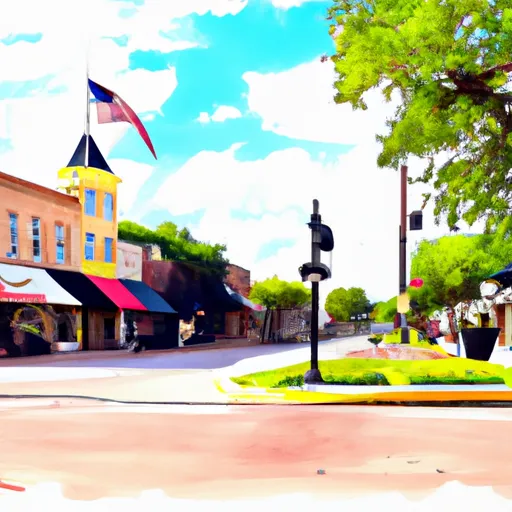-
 Snoflo Premium
Snoflo Premium
Get unlimited access to all our content
With no Ad interruptions! - Start Your Free Trial Login with existing account
Brenham
Eden Index
Climate
8.0
•
Recreation
5.0
•
Community
2.6
•
Safeguard
5.6/10

Brenham, Texas has a humid subtropical climate, with hot and humid summers and mild winters. The city is located near the Brazos River, which is the main source of water for the area. The hydrological constituents of the river include sediment, nutrients, and bacteria. Popular outdoor recreation opportunities in Brenham include hiking and biking through the beautiful countryside, fishing and boating on the Brazos River, and exploring the local parks and nature preserves. The area is also known for its bluebonnet fields, which attract visitors from around the world during the springtime. With its mild climate and abundant outdoor activities, Brenham is a great place for nature lovers and outdoor enthusiasts.
What is the Eden Index?
The Snoflo Eden Index serves as a comprehensive rating system for regions, evaluating their desirability through a holistic assessment of climate health, outdoor recreation opportunities, and natural disaster risk, acknowledging the profound impact of these factors on livability and well-being.
Climate Health Indicator (CHI): 8.0
Brenham receives approximately
1065mm of rain per year,
with humidity levels near 83%
and air temperatures averaging around
21°C.
Brenham has a plant hardyness factor of
9, meaning
plants and agriculture in this region tend to thrive here all year round.
By considering the ideal temperature range, reliable water supplies, clean air, and stable seasonal rain or snowpacks, the Climate Health Indicator (CHI) underscores the significance of a healthy climate as the foundation for quality living.
A healthy climate is paramount for ensuring a high quality of life and livability in a region, fostering both physical well-being and environmental harmony. This can be characterized by ideal temperatures, reliable access to water supplies, clean air, and consistent seasonal rain or snowpacks.
Weather Forecast
Streamflow Conditions
Lower Brazos
Area Rivers
Lower Brazos
Snowpack Depths
Lower Brazos
Reservoir Storage Capacity
Lower Brazos
Groundwater Levels
Recreational Opportunity Index (ROI): 5.0
The Recreational Opportunity Index (ROI) recognizes the value of outdoor recreational options, such as parks, hiking trails, camping sites, and fishing spots, while acknowledging that climate plays a pivotal role in ensuring the comfort and consistency of these experiences.
Access to outdoor recreational opportunities, encompassing activities such as parks, hiking, camping, and fishing, is crucial for overall well-being, and the climate plays a pivotal role in enabling and enhancing these experiences, ensuring that individuals can engage in nature-based activities comfortably and consistently.
Camping Areas
| Campground | Campsites | Reservations | Toilets | Showers | Elevation |
|---|---|---|---|---|---|
| Indianola County Historic Park | None | 3 ft | |||
| Magnolia Beach | None | 3 ft | |||
| Rocky Creek - Lake Somerville | 200 | 284 ft | |||
| Overlook - Lake Somerville | 65 | 273 ft | |||
| Lake Texana State Park | 55 | 51 ft | |||
| Yegua Creek - Lake Somerville | 80 | 282 ft | |||
| Lighthouse Beach RV Park | 55 | 5 ft | |||
| Oyster Lake County Park Dispersed | None | 1 ft | |||
| Brackenridge Plantation | None | 48 ft | |||
| Big Creek Park and Marina Dispersed | None | 250 ft |
Nearby Fishing
Nearby Ski Areas
Catastrophe Safeguard Index (CSI):
The Catastrophe Safeguard Index (CSI) recognizes that natural disaster risk, encompassing floods, fires, hurricanes, and tornadoes, can drastically affect safety and the overall appeal of an area.
The level of natural disaster risk in a region significantly affects safety and the overall livability, with climate change amplifying these risks by potentially increasing the frequency and intensity of events like floods, fires, hurricanes, and tornadoes, thereby posing substantial challenges to community resilience and well-being.
Community Resilience Indicator (CRI): 2.6
The Community Resilience Indicator (CRI) recognizes that education, healthcare, and socioeconomics are crucial to the well-being of a region. The CRI acknowledges the profound impact of these elements on residents' overall quality of life. By evaluating educational resources, healthcare accessibility, and economic inclusivity, the index captures the essential aspects that contribute to a thriving community, fostering resident satisfaction, equity, and social cohesion.

